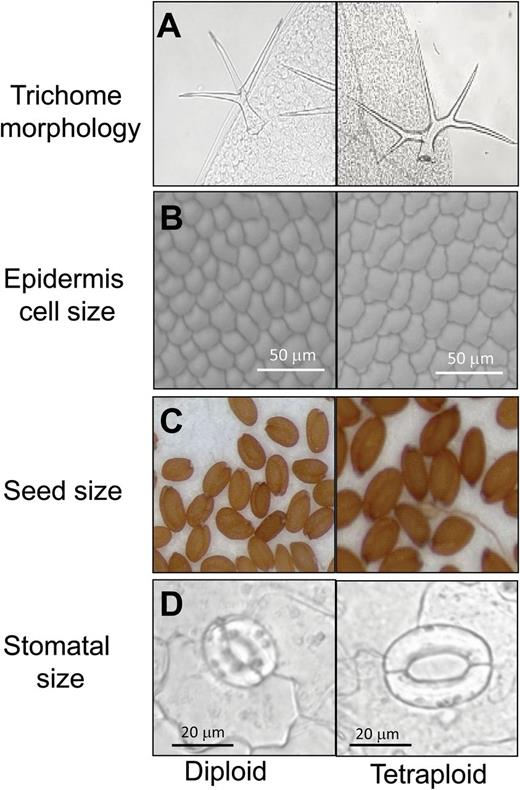Whole genome duplications in plants: an overview from Arabidopsis
Whole genome duplications in plants: an overview from Arabidopsis
Chromosome status in the genus Arabidopsis after polyploidization events. A. arenosa and A. thaliana persist as both diploid and autotetraploid. Allopolyploid A. suecica is formed by a single hybridization event between A. thaliana and A. arenosa. Mechanisms leading to autotetraploids and allotetraploids are indicated. Other non-shown genus members also suffer polyploidization. Thus, A. lyrata autotetraploid are also frequent and A. kamchatica is originated from multiple allopolyploidization events between A. halleri and A. lyrata. Figure shows also status of endoreplicated tissues obtained by development-associated endocycles. Endoreplication not only occurs during the development of A. thaliana, but also in A. suecica and A. arenosa.
Morphological features associated with autoploidy in Arabidopsis. (A) Characteristic trichome morphology visualized by microscopy from diploid and tetraploid leaf (28-d-old rosette leaf #3–4). Note five-branched trichome from autotetraploid Arabidopsis (Col-0). (B) Scanning micrography of petal cells from diploid and tetraploid flowers. Note that in all cases, cells of tetraploid flowers are larger than the diploid. (C) Seeds of diploid and tetraploid Col-0 plants. (D) Stomatal cells visualized by light microscopy from diploid and tetraploid leaf (28-d-old rosette leaf #3–4).
Abstract
Polyploidy is a common event in plants that involves the acquisition of more than two complete sets of chromosomes. Allopolyploidy originates from interspecies hybrids while autopolyploidy originates from intraspecies whole genome duplication (WGD) events. In spite of inconveniences derived from chromosomic rearrangement during polyploidization, natural plant polyploids species often exhibit improved growth vigour and adaptation to adverse environments, conferring evolutionary advantages. These advantages have also been incorporated into crop breeding programmes. Many tetraploid crops show increased stress tolerance, although the molecular mechanisms underlying these different adaptation abilities are poorly known. Understanding the physiological, cellular, and molecular mechanisms coupled to WGD, in both allo- and autopolyploidy, is a major challenge. Over the last few years, several studies, many of them in Arabidopsis, are shedding light on the basis of genetic, genomic, and epigenomic changes linked to WGD. In this review we summarize and discuss the latest advances made in Arabidopsis polyploidy, but also in other agronomic plant species.
資料來源:
https://photos.google.com/album/AF1QipMndldtPARuOYSSfRHHZCJadNHCCU0QR_WuactG



0 意見:
張貼留言